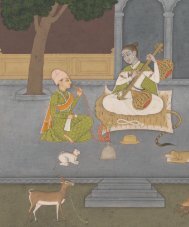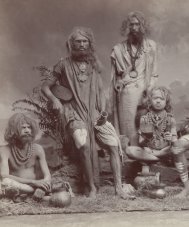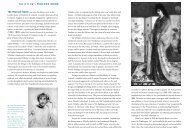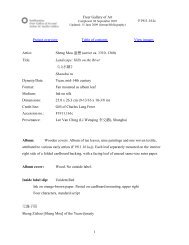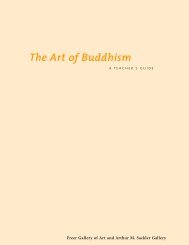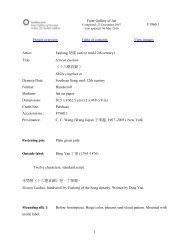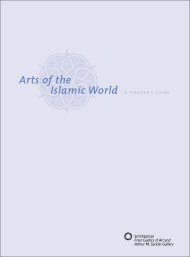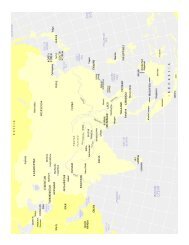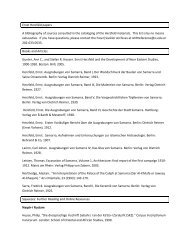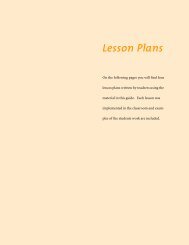Ancient China Timeline - Freer and Sackler Galleries - Smithsonian ...
Ancient China Timeline - Freer and Sackler Galleries - Smithsonian ...
Ancient China Timeline - Freer and Sackler Galleries - Smithsonian ...
You also want an ePaper? Increase the reach of your titles
YUMPU automatically turns print PDFs into web optimized ePapers that Google loves.
T h e A rt a n d A rc h a e o l o gy<br />
o f A n c i e nt C h i n a<br />
A T E A C H E R ’ S G U I D E
The Art <strong>and</strong> Archaeology<br />
of <strong>Ancient</strong> <strong>China</strong><br />
A T E A C H ER’S GUI DE
PROJECT DIRECTOR Carson Herrington<br />
WRITER Elizabeth Benskin<br />
PROJECT ASSISTANT Kristina Giasi<br />
EDITOR Gail Spilsbury<br />
DESIGNER Kimberly Glyder<br />
ILLUSTRATOR Ranjani Venkatesh<br />
CALLIGRAPHER John Wang<br />
TEACHER CONSULTANTS<br />
Toni Conklin, Bancroft Elementary School, Washington, D.C.<br />
Ann R. Erickson, Art Resource Teacher <strong>and</strong> Curriculum Developer,<br />
Fairfax County Public Schools, Virginia<br />
Krista Forsgren, Director, Windows on Asia, Atlanta, Georgia<br />
Christina Hanawalt, Art Teacher, Westfield High School, Fairfax County<br />
Public Schools, Virginia<br />
The maps on pages 4, 7, 10, 12, 16, <strong>and</strong> 18 are courtesy of the Minneapolis<br />
Institute of Arts. The map on page 106 is courtesy of Maps.com.<br />
Special thanks go to Jan Stuart <strong>and</strong> Joseph Chang, associate curators<br />
of Chinese art at the <strong>Freer</strong> <strong>and</strong> <strong>Sackler</strong> galleries, <strong>and</strong> to Paul Jett, the<br />
museum’s head of Conservation <strong>and</strong> Scientific Research, for their<br />
advice <strong>and</strong> assistance. Thanks also go to Michael Wilpers, Performing<br />
Arts Programmer, <strong>and</strong> to Christine Lee <strong>and</strong> Larry Hyman for their<br />
suggestions <strong>and</strong> contributions. This publication was made possible<br />
by a grant from the Freeman Foundation.<br />
The CD-ROM included with this publication was created in collaboration<br />
with Fairfax County Public Schools. It was made possible, in part, with inkind<br />
support from Kaidan Inc. <strong>and</strong> a grant from the Freeman Foundation.<br />
© 2003 <strong>Smithsonian</strong> Institution<br />
All rights reserved.<br />
FRONT COVER Detail, elephant-shaped ritual wine server. <strong>China</strong>, Yangzi<br />
River valley, Shang dynasty, ca. 1200–1100 B.C.E. Bronze; 17.2 x 10.7 x 21.4 cm.<br />
<strong>Freer</strong> Gallery of Art, <strong>Smithsonian</strong> Institution. Purchase, F1936.6
Table of Contents<br />
1 Introduction<br />
2 Overview of <strong>Ancient</strong> <strong>China</strong><br />
4 Historical Background<br />
4 Late Neolithic Period (ca. 5000–2000 B.C.E.)<br />
7 Xia Dynasty (ca. 21st–16th century B.C.E.)<br />
7 Shang Dynasty (ca. 1600–ca. 1050 B.C.E.)<br />
10 Zhou Dynasty (ca. 1050–221 B.C.E.)<br />
10 Western Zhou Dynasty (ca. 1050–771 B.C.E.)<br />
12 Eastern Zhou Dynasty (ca. 771–221 B.C.E.)<br />
14 focus on Confucianism <strong>and</strong> Daoism<br />
16 Qin Dynasty (221–206 B.C.E.)<br />
18 Han Dynasty (206 B.C.E.–220 C.E.)<br />
20 <strong>Timeline</strong><br />
23 Featured Objects<br />
24 Clothing <strong>and</strong> Personal Adornment<br />
26 focus on Silk<br />
27 focus on Jade<br />
28 Food Preparation <strong>and</strong> Utensils<br />
29 focus on Food in <strong>Ancient</strong> <strong>China</strong><br />
30 focus on Chinese Lacquers<br />
31 Transportation<br />
33 Ceremonies<br />
35 focus on Music in <strong>Ancient</strong> <strong>China</strong><br />
38 Writing<br />
40 focus on Chinese Characters<br />
42 Industry<br />
43 focus on Bronze Casting<br />
44 Building<br />
46 Threads of <strong>Ancient</strong> Practice:<br />
Ancestor Worship Today<br />
46 focus on Worshiping the Ancestors<br />
47 Ancestor Worship Today: Teen Research<br />
49 focus on Grave Sweeping Day (Qingming jie)<br />
52 Vocabulary<br />
55 Pronunciation Guide<br />
59 Lesson Plans<br />
60 lesson plan 1<br />
e lemen tary school lev e l <strong>and</strong> up<br />
Jing’s Gui <strong>and</strong> the Timeless Art of Gift-Giving<br />
68 lesson plan 2<br />
e lemen tary school lev e l<br />
Riddle of the Chinese Chimera, Dragon,<br />
<strong>and</strong> Taotie<br />
80 lesson plan 3<br />
h igh school lev e l<br />
Treasures of <strong>Ancient</strong> Chinese Tombs<br />
90 lesson plan 4<br />
middle school/h igh school lev e l<br />
Dragon-Bone Soup<br />
98 Resources<br />
98 The Legacy of <strong>Ancient</strong> Chinese Music:<br />
Special Recommendations<br />
101 Books <strong>and</strong> Magazines<br />
103 CD-ROM<br />
103 Videos<br />
105 National Educational Resources<br />
106 Political Map of <strong>China</strong><br />
CD-ROM: Chi’s Adventure in <strong>Ancient</strong> <strong>China</strong> (back pocket)<br />
8 x 10-inch color reproductions (back pocket)<br />
III
IV<br />
ART S OF T H E ISLA MIC W ORLD
Introduction<br />
Meet Chi<br />
This animal, with its catlike spine, fangs, long<br />
tail, <strong>and</strong> sharp claws, is often mistaken by<br />
Westerners for a dragon. Although it looks similar,<br />
it is actually a chimera, an imaginary<br />
horned creature with the head of a dragon, the<br />
body of a lion, <strong>and</strong> the wings of a bird. Inspired<br />
by a prototype from West Asia transmitted to<br />
<strong>China</strong>, the Chinese chimera came to symbolize<br />
peace <strong>and</strong> prosperity.<br />
Images of chimeras were sometimes placed in<br />
tombs; large images of chimeras were used as<br />
tomb guardians <strong>and</strong> were believed to protect<br />
the deceased against evil spirits <strong>and</strong> to prevent<br />
tomb violation. Small chimera images were<br />
often placed in tombs as auspicious symbols.<br />
The chimera, with its fierce beauty <strong>and</strong> association<br />
with prosperity, was also intended to glorify<br />
the memory of the deceased.<br />
ABOVE Chimera, <strong>China</strong>, Eastern Han dynasty, ca. 1st century C.E.<br />
Bronze; 19.3 x 36.6 x 13.7 cm. <strong>Freer</strong> Gallery of Art, <strong>Smithsonian</strong><br />
Institution. Purchase, F1961.3<br />
The Education Department of the <strong>Freer</strong> Gallery<br />
of Art <strong>and</strong> the Arthur M. <strong>Sackler</strong> Gallery has<br />
designed The Art <strong>and</strong> Archaeology of <strong>Ancient</strong><br />
<strong>China</strong> <strong>and</strong> Chi’s Adventure in <strong>Ancient</strong> <strong>China</strong> as<br />
resources for educators who wish to know<br />
more about the art, history, <strong>and</strong> culture of<br />
ancient <strong>China</strong>.<br />
This guide covers over five thous<strong>and</strong> years of<br />
Chinese history from the Late Neolithic Period<br />
(ca. 5000–2000 B.C.E.) to the Han dynasty (206<br />
B.C.E.–220 C.E.). Naturally, we had to be selective<br />
in our approach to such an extended<br />
period of history. We begin the guide with<br />
background information on the Late Neolithic<br />
Period <strong>and</strong> each dynasty through the Han.<br />
Following that, objects from our collection are<br />
used to illuminate aspects of ancient Chinese<br />
society, such as clothing <strong>and</strong> transportation. In<br />
the next section, “Threads of <strong>Ancient</strong> Practice:<br />
Ancestor Worship Today,” we present teen<br />
research on the contemporary practice of<br />
ancestor worship by local Chinese Americans.<br />
Finally, we include four lesson plans inspired<br />
by objects featured in this volume.<br />
This packet also includes the CD-ROM Chi’s<br />
Adventure in <strong>Ancient</strong> <strong>China</strong>. In this virtual tour,<br />
Chi (pronounced kai, short for chimera),<br />
an animated chimera, introduces students to<br />
the objects featured in the guide (see Chi<br />
at left). It is appropriate for students aged<br />
eight <strong>and</strong> older.<br />
We hope that this guide will help educators<br />
better underst<strong>and</strong> early Chinese history, <strong>and</strong><br />
that its materials will stimulate engaging<br />
ways to teach about life in ancient <strong>China</strong>.<br />
OPPOSIT E PA GE Detail, ritual wine vessel (sangzun). <strong>China</strong>, Western<br />
Zhou dynasty, late 11th–early 10th century B.C.E. Bronze; 34.5 x 27.0 cm.<br />
<strong>Freer</strong> Gallery of Art, <strong>Smithsonian</strong> Institution. Purchase, F1925.2
2<br />
Overview<br />
of <strong>Ancient</strong> <strong>China</strong><br />
Chi na is one of the world’s oldest continuous civ i liza tions,<br />
dating back more than seven thous<strong>and</strong> years. What is often referred to as “ancient <strong>China</strong>”<br />
is actually a very long period of history, from approximately 5000 B.C.E. to 220 C.E. Chinese<br />
culture, like all cultures, has always been dynamic <strong>and</strong> changing. Over the course of its first<br />
five thous<strong>and</strong> years, <strong>China</strong> evolved from a series of Neolithic settlements into a formidable<br />
empire, ruled by the Han dynasty (206 B.C.E.–220 C.E.), with a civil service, thriving industries,<br />
large-scale construction projects, trade with countries to the west, <strong>and</strong> exploration<br />
to the east. This guide attempts to offer a small glimpse into <strong>China</strong>’s transformation by<br />
examining objects that reflect its evolution.<br />
<strong>China</strong>’s development did not involve just one cultural group in one set geographical<br />
location. Archaeological evidence shows that many different peoples lived in the area<br />
that now constitutes <strong>China</strong>. Some of these cultural groups became part of historically<br />
acknowledged Chinese dynasties, such as the Zhou, who were originally based in the Wei<br />
River valley <strong>and</strong> founded the Zhou dynasty (ca. 1050–221 B.C.E.). Other groups retained<br />
their distinct cultures—such as the Hakka people who originally came from the Yellow<br />
River valley but eventually settled in southern <strong>China</strong>—but still came to be considered<br />
culturally Chinese.<br />
How do we know about ancient Chinese life? Unlike the people of ancient Egypt who<br />
left behind pyramids <strong>and</strong> temples, the ancient Chinese did not build monumental structures<br />
out of non-perishable materials like stone. The Great Wall—one of the best-known<br />
examples of Chinese architecture—is one of the only monumental structures from<br />
ancient <strong>China</strong>. However, its construction, which began during the Eastern Zhou dynasty<br />
(ca. 771–221 B.C.E.), went through many stages of development, <strong>and</strong> it did not take its present<br />
form until the sixteenth century. Until the Zhou dynasty, from which extensive written<br />
records survive, there were few written sources to inform us about Chinese society.<br />
THE ART AND ARCHAEOLOGY OF ANCIENT CHINA<br />
Detail, bell (bo zhong). <strong>China</strong>, Shang dynasty, ca. 12th–11th<br />
century B.C.E. Bronze; 31.0 x 24.8 x 15.2 cm. Arthur M. <strong>Sackler</strong><br />
Gallery, <strong>Smithsonian</strong> Institution. Gift of Arthur M. <strong>Sackler</strong>, S1987.10
There are many ways of learning about ancient cultures, including the study of settlement<br />
sites, human remains, <strong>and</strong> oral <strong>and</strong> written histories. For ancient <strong>China</strong>, tombs offer<br />
especially in-depth historic information on Chinese society over the course of thous<strong>and</strong>s<br />
of years. They not only provide information about burial rituals but also reveal information<br />
about art, cuisine, technology, scholarship, entertainment, <strong>and</strong> social classes. Like the<br />
ancient Egyptians, the ancient Chinese had their own beliefs about the afterlife <strong>and</strong> furnished<br />
their tombs with objects that would be useful <strong>and</strong> pleasing to the dead in their next<br />
life. The Chinese elite were often buried with jades, weapons, tomb guardians, musical<br />
instruments, bronze ritual vessels, <strong>and</strong> ceramic architectural models <strong>and</strong> figures. They also<br />
were buried with textiles <strong>and</strong> objects made of more fragile materials such as wood. These<br />
materials usually did not survive, but the many objects that did give useful clues to underst<strong>and</strong>ing<br />
ancient <strong>China</strong>.<br />
Objects from ancient <strong>China</strong> are, in the present day, often referred to as “art.” However, it<br />
should be noted that what is called “art” was not necessarily made at the time as fine art—<br />
many of these objects had ritual or practical functions when new, but gradually became<br />
valued for their aesthetic qualities.<br />
The discovery <strong>and</strong> study of objects from ancient <strong>China</strong> is ongoing; thus, scholars today<br />
may draw different conclusions about objects than scholars twenty years ago. Newly excavated<br />
objects may change the interpretation of how an object was used, or how it reflected<br />
on life at the time it was made. Regardless of how the story of ancient <strong>China</strong> continues<br />
to evolve, archaeological <strong>and</strong> art objects remain central to our underst<strong>and</strong>ing of <strong>China</strong>’s<br />
earliest history.<br />
3
4<br />
Historical<br />
Background<br />
Late Neolithic Period (ca. 5000–2000 B.C.E.)<br />
Traditionally Chinese civilization is believed to have<br />
emerged in the Yellow River valley. However, recent<br />
archaeological evidence shows that the origin of Chinese<br />
civilization is much more complex. During the Neolithic<br />
Period, a number of distinct cultures lived in settlements<br />
in today’s mainl<strong>and</strong> <strong>China</strong>. Each of these cultures was<br />
different but with shared characteristics. All were settled<br />
agricultural communities with domesticated pigs <strong>and</strong><br />
dogs. The diet included staples of millet or rice, supplemented by fish <strong>and</strong> game. Finally,<br />
there is evidence, in all of these cultures, of extensive pottery production. Ceramic vessels<br />
like these were often placed in tombs during the Neolithic Period, suggesting that Neolithic<br />
people placed objects in tombs to reflect the high status of the tomb’s occupant, the way<br />
the elite of later dynasties used bronzes (fig. 1).<br />
These cultures also produced jade objects for the elite (see Focus on Jade, page 27),<br />
including personal ornaments, such as bracelets, earrings, <strong>and</strong> pendants, <strong>and</strong> other objects<br />
designed for ceremonial use, such as ax heads <strong>and</strong> knives. Archaeologists also found that<br />
the Liangzhu culture—centered along <strong>China</strong>’s southeast coast—made jade objects shaped<br />
like disks (bi) <strong>and</strong> tubes (cong; figs. 2 <strong>and</strong> 3) in large numbers, but the actual function of<br />
these objects is still not known. For instance, in one important tomb, thirty-three cong<br />
were lined up end to end around the deceased. Although the reason for this configuration<br />
remains a mystery, it is likely that it was ritual in nature.<br />
THE ART AND ARCHAEOLOGY OF ANCIENT CHINA<br />
Detail, ritual wine vessel (fangyi). <strong>China</strong>, Shang dynasty, 12th–11th<br />
century B.C.E. Bronze; 19.1 x 10.7 x 7.7 cm. <strong>Freer</strong> Gallery of Art,<br />
<strong>Smithsonian</strong> Institution. Purchase, F1954.13
FIGURE 2<br />
Ritual disk (bi)<br />
<strong>China</strong>, Neolithic Period, Liangzhu culture<br />
4th–3d millennium B.C.E.<br />
Jade, 17.5 x 16.7 x 1.2 cm<br />
Arthur M. <strong>Sackler</strong> Gallery, <strong>Smithsonian</strong> Institution<br />
Gift of Arthur M. <strong>Sackler</strong>, S1987.929<br />
The round shape of the bi has often been<br />
associated with heaven by later Chinese,<br />
but it is not known if that was its meaning<br />
during the Neolithic Period.<br />
FIGURE 1<br />
Storage jar<br />
Northwest <strong>China</strong>, Machang culture<br />
Late Neolithic Period, ca. 2400–2000 B.C.E.<br />
Earthenware with painted decoration, 24.5 x 21.2 cm<br />
<strong>Freer</strong> Gallery of Art, <strong>Smithsonian</strong> Institution<br />
Gift of Mrs. Anna C. Chennault, F1973.18<br />
Neolithic cultures inhabited areas all over<br />
present-day <strong>China</strong>. This storage jar is an<br />
example of the ceramic production of the<br />
Neolithic Machang culture from northwest<br />
<strong>China</strong>. The jar’s geometric design of four<br />
large circles in black <strong>and</strong> reddish-brown<br />
is characteristic of Machang ceramics.<br />
5
6<br />
THE ART AND ARCHAEOLOGY OF ANCIENT CHINA<br />
FIGURE 3<br />
Ritual tube (cong)<br />
<strong>China</strong>, Neolithic Period, Liangzhu culture<br />
4th–3d millennium B.C.E.<br />
Jade, 22.1 x 7.5 x 7.6 cm<br />
Arthur M. <strong>Sackler</strong> Gallery, <strong>Smithsonian</strong> Institution<br />
Gift of Arthur M. <strong>Sackler</strong>, S1987.468<br />
Cong, such as this one, were used in burial<br />
rites during the Neolithic Period, but their<br />
significance is still unknown. Jade is<br />
extremely hard to shape, so that this<br />
object—square on the outside <strong>and</strong> round<br />
on the inside—reflects the high level of<br />
Chinese Neolithic jadework <strong>and</strong> the importance<br />
of jade, as so much time was invested<br />
in working it into this particular shape.
Xia Dynasty (ca. 21st–16th century B.C.E.)<br />
By the Zhou dynasty, written texts made references to the first dynasty of <strong>China</strong>—<br />
the Xia dynasty, founded by King Yu. Most scholars today are still awaiting definitive<br />
archaeological evidence of the existence of the Xia, although some scholars believe that it<br />
was based at the archaeological site of Erlitou, located on the Yellow River in present-day<br />
Henan Province.<br />
Shang Dynasty (ca. 1600–ca. 1050 B.C.E.)<br />
Around 1600 B.C.E., the Shang people established the<br />
earliest Chinese dynasty verified by archaeology. During<br />
the Shang dynasty, many people lived in walled settlements,<br />
some of them significantly larger than those of<br />
the late Neolithic Period. From about 1300 to 1050 B.C.E.,<br />
the Shang royal family ruled its people from a central<br />
capital near the town of Anyang; previously it had<br />
been located in Erligang. Both Anyang <strong>and</strong> Erligang<br />
were located in present-day Henan Province.<br />
The religious life of the Shang royal family is responsible for many of the dynasty’s<br />
objects that we have available for study today. The most important role of the Shang king<br />
was that of spiritual go-between for the royal clan, his subjects, <strong>and</strong> the gods. In Shang<br />
belief, the highest deity was Di, or Shang Di, a powerful force that ruled over the known<br />
universe. Shang Di also ruled over other spirits, including nature spirits <strong>and</strong> the spirits of<br />
royal ancestors. The king was responsible for performing rites to ensure the health <strong>and</strong><br />
well-being of his family <strong>and</strong> subjects. This was often done by appealing directly to the<br />
royal ancestors, who were believed to act as intermediaries between the king <strong>and</strong> Shang Di.<br />
Divinations were also an important part of the king’s role as a political <strong>and</strong> religious<br />
leader. Large numbers of tortoiseshells <strong>and</strong> ox scapulae were used as oracle bones, on<br />
which to record questions that the king would ask the royal ancestor spirits. Shang kings<br />
asked about everything from the weather to the outcome of births, hunts, <strong>and</strong> battles<br />
(see the oracle-bone fragment, page 41). Thus, the Shang kings performed in important<br />
political roles by attending to issues of state through religious rituals.<br />
The religious rites of the Shang dynasty also reflect the importance of family relationships<br />
<strong>and</strong> lineage in Shang society—a value that has persisted throughout <strong>China</strong>’s history<br />
to the present day, as has the ritual of ancestor worship (see “Threads of <strong>Ancient</strong> Practice:<br />
Ancestor Worship Today,” page 46). It is also significant to note that throughout Chinese<br />
history (although changing today), dating at least as far back as the Shang dynasty,<br />
the male lineage has been considered the most important; thus, kings almost always<br />
HISTORICAL BACKGROUND 7
8<br />
conducted the formal ceremonies of worship rather than female members of the<br />
royal family.<br />
Bronze played an important role in both the religious <strong>and</strong> the military life of the<br />
Shang. Religious rites, which included human <strong>and</strong> animal sacrifices, also included<br />
offerings of wine <strong>and</strong> food presented in decorated bronze vessels. These ritual bronze<br />
vessels were frequently buried with members of the royal family. Wine vessels were one<br />
of the most popular bronze objects of the Shang dynasty <strong>and</strong> were often part of a set<br />
that included other bronzes, such as differently shaped wine vessels <strong>and</strong> food containers.<br />
The number <strong>and</strong> variety of wine vessels from the Shang suggest that wine played an<br />
important role in Shang religious rituals (see fig. 4, opposite page).<br />
The military relied on bronze technology for defense purposes. In readiness for potential<br />
conflicts, the Shang military force was equipped with bronze weapons <strong>and</strong> with chariots<br />
that had bronze fixtures.<br />
During the Shang dynasty, jade continued to be highly prized. Types of jade objects<br />
from the late Neolithic Period, including the bi <strong>and</strong> cong, were, again, made largely for<br />
ritual functions in the Shang; however, the Shang also produced many jades for personal<br />
ornamentation (fig. 5).<br />
FIGURE 5<br />
Tiger plaque<br />
<strong>China</strong>, Shang dynasty, 12th–11th century B.C.E.<br />
Jade, 4.5 x 9.4 x 0.6 cm<br />
Arthur M. <strong>Sackler</strong> Gallery, <strong>Smithsonian</strong> Institution<br />
Gift of Arthur M. <strong>Sackler</strong>, S1987.705<br />
Similar to the jades of the late Neolithic<br />
Period, many Shang-dynasty jade objects<br />
were made for use as personal ornaments.<br />
This tiger plaque was likely worn as a<br />
pendant hanging from the waist.<br />
THE ART AND ARCHAEOLOGY OF ANCIENT CHINA
FIGURE 4<br />
Ritual wine container (jia)<br />
<strong>China</strong>, Shang dynasty, 15th–14th century B.C.E.<br />
Bronze, 21.9 x 14.5 x 16.0 cm<br />
Arthur M. <strong>Sackler</strong> Gallery, <strong>Smithsonian</strong> Institution<br />
Gift of Arthur M. <strong>Sackler</strong>, S1987.41<br />
This particular wine vessel may have been<br />
used as a container for heating wine prior to<br />
its consumption during religious rites performed<br />
in the Shang royal temple.<br />
HISTORICAL BACKGROUND 9
10<br />
Zhou Dynasty (ca. 1050–221 B.C.E.)<br />
Western Zhou Dynasty (ca. 1050–771 B.C.E.)<br />
The Zhou people had their origins in the Wei River valley<br />
in present-day Shaanxi Province. Around 1050 B.C.E. this<br />
group conquered the Shang <strong>and</strong> established their own<br />
dynasty called the Zhou. The Zhou shared some cultural<br />
similarities with the Shang; most importantly, archaeological<br />
evidence suggests that they performed similar religious<br />
rituals, used bronze ritual vessels, <strong>and</strong> practiced divination. During its first 279 years,<br />
the Zhou dynasty mirrored the Shang in that it ruled as a centralized monarchy. Also, the<br />
kind of bronze casting <strong>and</strong> jadework characteristic of the Shang continued uninterrupted.<br />
The Zhou used Shang bronze design as a foundation for their own decorative bronzework,<br />
but they also introduced new motifs <strong>and</strong> shapes (fig. 6).<br />
In 771 B.C.E., the Zhou l<strong>and</strong>s were invaded by a nomadic people. In response to this<br />
attack, some bronze objects were hastily buried in pits to protect them but were never<br />
recovered by their owners. These pits, uncovered in the late twentieth century, have<br />
provided archaeologists <strong>and</strong> art historians with a unique source for bronzes that were<br />
not necessarily destined for burial in tombs. These bronzes have proved particularly<br />
useful for their inscriptions, which were longer <strong>and</strong> more detailed during the Zhou than<br />
anything known in the Shang (fig. 6; see also the ritual food container [gui], page 38).<br />
At the time of the invasion, Zhou rulers fled to the east <strong>and</strong> established a new capital at<br />
present-day Luoyang. This marked the beginning of the period known as the Eastern Zhou<br />
dynasty (771–221 B.C.E.).<br />
THE ART AND ARCHAEOLOGY OF ANCIENT CHINA
FIGURE 6<br />
Ritual food container (fang ding)<br />
<strong>China</strong>, Western Zhou dynasty, 11th century B.C.E.<br />
Bronze, 24.3 x 18.3 x 14.9 cm<br />
Arthur M. <strong>Sackler</strong> Gallery, <strong>Smithsonian</strong> Institution<br />
Gift of Arthur M. <strong>Sackler</strong>, S1987.305<br />
This square, four-legged food container is a popular Shang<br />
type, <strong>and</strong> the taotie masks found on the legs also decorate<br />
numerous Shang bronzes. (For a discussion of taotie masks,<br />
see the ritual wine container [you], page 42.) However,<br />
the snakelike creature with one head <strong>and</strong> two bodies<br />
<strong>and</strong> the small projecting knobs are elements of Western<br />
Zhou design.<br />
Inside this vessel, an inscription of nine characters appears<br />
to be a dedication of the vessel to a group of ancestors,<br />
including “Gr<strong>and</strong>father Ding” <strong>and</strong> “Father Gui.” This dedication<br />
reflects both the rise in bronze inscriptions during<br />
the Zhou dynasty—in comparison to the Shang—<strong>and</strong> the<br />
continued importance of ancestral spirits.<br />
Detail, ritual food container inscription.<br />
Another aspect of the inscription<br />
worth noting is the pictograph in the<br />
upper right of the inscription (see<br />
Focus on Chinese Characters, page 40).<br />
The pictograph depicts a basin in<br />
which a kneeling figure holds a shaft<br />
decorated with a trident <strong>and</strong> an<br />
unfurled banner. Its large size <strong>and</strong> pictorial<br />
quality suggest that it is a clan<br />
sign. The clan—a large group with a<br />
common ancestor–– has been an<br />
important social unit throughout<br />
Chinese history. Many clans, including<br />
the royal clan, built temples specifically<br />
to honor their own ancestors.<br />
HISTORICAL BACKGROUND 11
12<br />
Eastern Zhou Dynasty (771–221 B.C.E.)<br />
The Eastern Zhou was a period of intense political turmoil<br />
but also one of great cultural <strong>and</strong> artistic development.<br />
The move to the east in response to the nomadic<br />
invasion weakened the power of the Zhou kings, who<br />
allowed royal family members <strong>and</strong> noblemen to rule<br />
states in the Zhou kingdom. As the kings’ power became<br />
increasingly decentralized, states began fighting each<br />
other for l<strong>and</strong> <strong>and</strong> political control. In fact, the latter half<br />
of the Eastern Zhou dynasty, from 475 to 221 B.C.E., is known as the Warring States Period.<br />
This weakening of central Zhou authority is reflected in the bronze objects of the<br />
period, which were no longer used solely for state <strong>and</strong> religious rituals. With increased<br />
power, state rulers commissioned <strong>and</strong> purchased bronze objects to represent their status<br />
<strong>and</strong> wealth, which led to a boom in the bronze-casting industry. Inscriptions on bronze<br />
works lengthened, reflecting the elite’s desire to show off its status (see the ritual food container<br />
[gui], page 38). New decorative techniques increased the variety <strong>and</strong> intricacy of<br />
these bronzes, <strong>and</strong> new casting techniques (such as the lost-wax process) led to an even<br />
greater range of styles <strong>and</strong> decoration (see Focus on Bronze Casting, page 43). Finally,<br />
the influence of other cultural groups also contributed to new designs (fig. 7).<br />
Relative to the jade objects of the Shang, those of the Zhou were larger in number<br />
<strong>and</strong> made in a wider variety of styles. Like bronzes during this period, jade objects were<br />
used less often as ritual objects <strong>and</strong> more often as ornaments <strong>and</strong> symbols of status <strong>and</strong><br />
wealth (fig. 8)<br />
The arts <strong>and</strong> humanities flourished during the Eastern Zhou dynasty. There is ample<br />
information available about the music of this period because of the discovery in tombs<br />
of musical instruments <strong>and</strong> figures of performers (see Focus on Music in <strong>Ancient</strong> <strong>China</strong>,<br />
page 35). The Eastern Zhou was also the time of Confucius, Laozi, <strong>and</strong> many other<br />
philosophers, who addressed the question of how to create a stable <strong>and</strong> harmonious<br />
society (see Focus on Confucianism <strong>and</strong> Daoism, page 14).<br />
THE ART AND ARCHAEOLOGY OF ANCIENT CHINA
FIGURE 8<br />
Fish-dragon pendant<br />
<strong>China</strong>, Eastern Zhou dynasty, 4th century B.C.E.<br />
Jade, 3.4 x 10.2 x 0.4 cm<br />
Arthur M. <strong>Sackler</strong> Gallery, <strong>Smithsonian</strong> Institution<br />
Gift of Arthur M. <strong>Sackler</strong>, S1987.641<br />
This tiny pendant measures only a few inches in length,<br />
but it demonstrates extraordinary precision <strong>and</strong> detail.<br />
Its crescent shape forms a beautiful arc, giving the object<br />
a sense of flowing movement, enhanced by a stylized<br />
ear that points backwards as though being swept back<br />
from the creature’s head. A curving incised line defines<br />
its nostril in a spiral at the tip of its head, traces the<br />
snout, <strong>and</strong> outlines the open mouth. The body is covered<br />
with “raised dots” that are actually a regular pattern of<br />
minute, raised spirals suggestive of fish or dragon scales.<br />
FIGURE 7<br />
Ritual wine container (hu)<br />
<strong>China</strong>, Eastern Zhou dynasty, 7th–6th century B.C.E.<br />
Bronze, 38.0 x 13.4 x 15.2 cm<br />
Arthur M. <strong>Sackler</strong> Gallery, <strong>Smithsonian</strong> Institution<br />
Gift of Arthur M. <strong>Sackler</strong>, S1987.325<br />
The asymmetry of this vessel is in contrast to<br />
the majority of ancient Chinese bronze objects.<br />
Its shape suggests that it is meant to imitate<br />
the drinking flasks made of animal skin that<br />
were typically used by nomadic peoples living<br />
along <strong>China</strong>’s northern fringes. The peoples<br />
north of the Great Wall were generally considered<br />
a threat, but at the same time, exchange<br />
with these groups seems to have had an influence<br />
on the design of this particular vessel.<br />
HISTORICAL BACKGROUND 13
14<br />
focus on<br />
Confucianism<br />
Confucianism has been one of the most important<br />
cultural forces in all of Chinese history.<br />
Based on a system of thought developed by<br />
Confucius (Kong Qiu, 551–479 B.C.E.), Confucianism<br />
stresses the importance of a person’s correct<br />
placement in the social <strong>and</strong> family structure <strong>and</strong><br />
also filial piety—a child showing respect for his<br />
or her parents. To Confucius, the family provided<br />
the best model for the structure of human society.<br />
Confucius also dedicated much of his teaching<br />
to defining what constituted a good ruler.<br />
Born in 551 B.C.E. in the state of Lu (present-day<br />
Sh<strong>and</strong>ong Province), when individual states of<br />
the Zhou dynasty were at war, Confucius was<br />
deeply distressed by the period’s political unrest.<br />
The Analects<br />
The Analects are the teachings of<br />
Confucius recorded by his followers.<br />
Comprised of quotations, dialogues<br />
between Confucius <strong>and</strong> his disciples,<br />
<strong>and</strong> passages describing Confucius in<br />
his daily life, The Analects form the<br />
basis for Confucian thought.<br />
Confucius on personal duty<br />
I:6<br />
The Master said, A young man’s<br />
duty is to behave well to his parents<br />
at home <strong>and</strong> to his elders abroad, to<br />
be cautious in giving promises <strong>and</strong><br />
punctual in keeping them, to have<br />
kindly feelings toward everyone, but<br />
seek the intimacy of the Good.<br />
If, when all that is done, he has any<br />
energy to spare, then let him study<br />
the polite arts.<br />
Confucius on good government<br />
I:5<br />
The Master said, A country of a thous<strong>and</strong><br />
war-chariots cannot be administered<br />
unless the ruler attends strictly<br />
to business, punctually observes his<br />
promises, is economical in expenditure,<br />
shows affection toward his subjects<br />
in general, <strong>and</strong> uses the labour of<br />
the peasantry only at the proper<br />
times of the year.<br />
THE ART AND ARCHAEOLOGY OF ANCIENT CHINA<br />
He taught principles he felt would help leaders<br />
usher in an age of stability <strong>and</strong> harmony.<br />
Confucius stressed that a leader’s moral<br />
qualities were the key components of a stable<br />
<strong>and</strong> just government. A leader was expected<br />
to behave as a “gentleman” by developing three<br />
crucial qualities—filial piety, humaneness<br />
(specifically, compassion toward his subjects),<br />
<strong>and</strong> ritual decorum (following the correct rites).<br />
By cultivating these qualities, a leader would<br />
develop the ability to rule in a humane <strong>and</strong><br />
sensible manner. Confucius believed this<br />
would result in contented subjects <strong>and</strong> a<br />
prosperous society.<br />
II:20<br />
Chi K’ang Tzu [Qi Kangzi] asked<br />
whether there were any form of<br />
encouragement by which he could<br />
induce the common people to be<br />
respectful <strong>and</strong> loyal. The Master said,<br />
Approach them with dignity, <strong>and</strong> they<br />
will respect you. Show piety toward<br />
your parents <strong>and</strong> kindness toward<br />
your children, <strong>and</strong> they will be loyal to<br />
you. Promote those who are worthy,<br />
train those who are incompetent; that<br />
is the best form of encouragement.<br />
From Arthur Waley, translator,<br />
The Analects of Confucius, New York:<br />
Vintage Books, 1989.
Daoism<br />
Daoism is a complex system of beliefs that can<br />
be loosely divided into two overlapping categories:<br />
philosophical Daoism <strong>and</strong> religious<br />
Daoism. Philosophical Daoism is based on principles<br />
outlined in the Daode jing, traditionally<br />
attributed to Laozi (Li Er, 6th century B.C.E.; fig. 9).<br />
The Daode jing outlines the principles of Daoism,<br />
advocating that all people follow the dao, or the<br />
“Way,” the natural path of the universe. In contrast<br />
to the Confucian emphasis on strict adherence<br />
to one’s role in society, Daoism emphasized<br />
one’s relationship to the universe <strong>and</strong> stressed<br />
the importance of attuning oneself to the flow<br />
of the dao.<br />
Philosophical Daoism had a profound effect<br />
on art <strong>and</strong> society in <strong>China</strong>. Artists <strong>and</strong> scholars<br />
drew inspiration from its appreciation of nature<br />
<strong>and</strong> natural rhythms <strong>and</strong> also from the concept<br />
of following the dao as one moved throughout<br />
human society, or detached oneself from it.<br />
Religious Daoism, while drawing from important<br />
concepts of philosophical Daoism, developed<br />
into a belief system complete with deities,<br />
rituals, temples, <strong>and</strong> a priesthood. In religious<br />
Daoism, the three supreme deities are called the<br />
“Three Pure Ones,” one of whom is sometimes<br />
Daode jing<br />
The Daode jing is a poetic work that describes the benefits<br />
of following the dao or the “Way.” It calls for a kind of “nonaction”<br />
as a way of acting in accordance with the dao. As it<br />
states in one passage:“The Way is constant: by doing nothing,<br />
nothing is left undone.”<br />
Daode jing on the nature of the dao (the<br />
“Way”)<br />
1<br />
The Way that can be spoken of is not the constant Way;<br />
The name that can be named is not the constant name.<br />
The nameless is the beginning of Heaven <strong>and</strong> Earth;<br />
The named is the mother of all things.<br />
Daode jing on human society<br />
18<br />
When the great Way declined,<br />
There were humaneness <strong>and</strong> rightness.<br />
When intelligence <strong>and</strong> wisdom emerged,<br />
identified as Laozi. Other deities include the<br />
Queen Mother of the West, who is associated<br />
with immortality, the Jade emperor who rules a<br />
heavenly court, <strong>and</strong> various nature deities.<br />
Throughout the history of religious Daoism,<br />
some adherents focused their attention on<br />
alchemy <strong>and</strong> the quest for immortality. The<br />
interest in longevity also led to the development<br />
of various practices, such as qigong, the control<br />
of the breath, <strong>and</strong> taijiquan (often known as<br />
“tai chi” in the West), the practice of controlling<br />
the flow of qi (breath or energy) throughout<br />
the body.<br />
As with other religious traditions in <strong>China</strong>, the<br />
practice of religious Daoism throughout the centuries<br />
has often overlapped with or incorporated<br />
aspects of other traditions, such as ancestor worship<br />
<strong>and</strong> Confucianism.<br />
FIGURE 9<br />
Laozi Delivering His Canon<br />
<strong>China</strong>, Ming dynasty,<br />
16th century<br />
Ink on paper, 24.8 x 51.8 cm<br />
<strong>Freer</strong> Gallery of Art,<br />
<strong>Smithsonian</strong> Institution<br />
Gift of Eugene <strong>and</strong><br />
Agnes E. Meyer, F1968.21<br />
There was great artifice.<br />
When the six relations* were no longer harmonious,<br />
There were filial children.<br />
When the realm fell into disorder,<br />
There were loyal ministers.<br />
* “The six relations” refers to the relationships between parent<br />
<strong>and</strong> child, older <strong>and</strong> younger brother, <strong>and</strong> husb<strong>and</strong> <strong>and</strong> wife.<br />
19<br />
Do away with sageliness, discard knowledge,<br />
And the people will benefit a hundredfold.<br />
Do away with humaneness, discard rightness,<br />
And the people will once more be filial <strong>and</strong> loving,<br />
Dispense with cleverness, discard profit,<br />
And there will be no more b<strong>and</strong>its <strong>and</strong> thieves.<br />
From Wm. Theodore de Bary <strong>and</strong> Irene Bloom, compilers,<br />
Sources of Chinese Tradition, New York: Columbia University<br />
Press, 1999.<br />
HISTORICAL BACKGROUND 15
16<br />
Qin Dynasty (221–206 B.C.E.)<br />
The Qin dynasty was established when the state of Qin<br />
conquered all other states at the end of the Warring States<br />
Period, thereby unifying a <strong>China</strong> that had fractured during<br />
the Eastern Zhou dynasty. The first emperor of<br />
Qin—known as Qin shihuangdi (259–210 B.C.E.)—<br />
st<strong>and</strong>ardized weights <strong>and</strong> measures, coinage, <strong>and</strong> the writing<br />
system, setting st<strong>and</strong>ards that would last for centuries<br />
after the fall of his short-lived dynasty.<br />
Qin shihuangdi was a severe leader. He was intolerant of any threats to his rule <strong>and</strong> kept<br />
tight control on all states within <strong>China</strong> by keeping their leaders in the capital with him. He<br />
had his chief adviser burn all books that were not written on topics he considered useful—such<br />
as gardening—<strong>and</strong> reportedly buried hundreds of scholars alive.<br />
The Qin dynasty has become one of the best-known periods in Chinese history in<br />
the West because of the discovery in 1974 of thous<strong>and</strong>s of terra-cotta warriors buried in the<br />
tomb of Qin shihuangdi in present-day Xi’an (figs. 10a–b). These warriors were modeled<br />
after general categories of soldiers—such as archers <strong>and</strong> infantrymen—but were also<br />
given some individual characteristics. They reflect Qin shihaungdi’s reliance on the military<br />
to create <strong>and</strong> maintain a unified <strong>China</strong> <strong>and</strong> indicate the emperor’s desire to have the<br />
resources of an army in the afterlife.<br />
The Qin dynasty collapsed following the death of Qin shihuangdi in 210 B.C.E., <strong>and</strong><br />
for the next four years <strong>China</strong> was in a state of chaos. Then, in 206 B.C.E., a peasant leader by<br />
the name of Liu Bang led his followers to reunite <strong>China</strong> <strong>and</strong> became the first ruler of the<br />
newly founded Han dynasty.<br />
THE ART AND ARCHAEOLOGY OF ANCIENT CHINA
FIGURE 10a<br />
Horses were a crucial component of the Chinese military,<br />
dating back to the Shang dynasty (ca. 1600–ca. 1050 B.C.E.).<br />
Horse figures found in Qin shihuangdi’s tomb were either<br />
placed next to members of the cavalry or attached to chariots.<br />
FIGURE 10b<br />
In 1974, local farmers discovered the burial site of Qin<br />
shihuangdi, which contained thous<strong>and</strong>s of terra-cotta<br />
warriors arranged in battle formation. Each warrior was<br />
made in a workshop from one of several different molds,<br />
then given individual features by ceramic specialists.<br />
The terra-cotta warriors reflect the comm<strong>and</strong> of extensive<br />
human <strong>and</strong> natural resources during Qin shihuangdi’s reign.<br />
PHOTOGRAPHS BY KRISTINA GIASI.<br />
HISTORICAL BACKGROUND 17
18<br />
Han Dynasty (206 B.C.E.–220 C.E.)<br />
The Han dynasty was a pivotal period in the history<br />
of <strong>China</strong>. During this four-hundred-year dynasty, more<br />
foundations were laid for enduring aspects of Chinese<br />
society. Daoism continued to grow in influence, <strong>and</strong><br />
Buddhism was introduced from India via the Silk Route<br />
as well as by a southern route (fig. 11). A civil service was<br />
created with entrance examinations based on Confucian<br />
texts (see Focus on Confucianism <strong>and</strong> Daoism, page 14),<br />
a system that continued through the early twentieth century.<br />
Under Han rulers, <strong>China</strong> exp<strong>and</strong>ed its territories <strong>and</strong> blossomed artistically. Later<br />
on, however, rebellions <strong>and</strong> imperial power struggles weakened the dynasty so that it<br />
eventually fell in the second century.<br />
During the Han dynasty, bronzes <strong>and</strong> jades became even more closely associated with<br />
affluence <strong>and</strong> luxury than in any previous dynasty. In contrast to their use in religious<br />
rituals of the Shang dynasty, these items became objects for gr<strong>and</strong> festivities <strong>and</strong> personal<br />
consumption. At the same time, increased contact with India, Persia, <strong>and</strong> other countries<br />
along the Silk Route added to the variety of symbols, motifs, <strong>and</strong> techniques in<br />
Chinese art.<br />
THE ART AND ARCHAEOLOGY OF ANCIENT CHINA
FIGURE 11<br />
Mirror<br />
<strong>China</strong>, Han dynasty, 2d–3d centuries C.E.<br />
Bronze, diameter 19.5 cm<br />
Arthur M. <strong>Sackler</strong> Gallery, <strong>Smithsonian</strong> Institution<br />
Lent by the Arthur M. <strong>Sackler</strong> Collections, MLS1793<br />
This bronze mirror is the kind of luxury item popular with the Han-dynasty elite. One side is highly<br />
polished for reflection, <strong>and</strong> the other is decorated with designs in relief. On opposite sides of the<br />
central knob are the Daoist deities Xiwangmu (Queen Mother of the West) <strong>and</strong> Dongwanggong<br />
(King Father of the East). Both of these deities are shown with attendants who are slightly smaller<br />
in scale. Several of these attendants are “immortals” who wear feathered costumes. Positioned<br />
between these groups are the Green Dragon of the East <strong>and</strong> the White Tiger of the West. The rising<br />
<strong>and</strong> setting suns represent East <strong>and</strong> West.<br />
The depiction of deities from Daoist belief on this mirror illustrates the growing popularity of<br />
religious Daoism during the Han dynasty (see Focus on Confucianism <strong>and</strong> Daoism, page 14).<br />
HISTORICAL BACKGROUND 19
20<br />
<strong>Ancient</strong> <strong>China</strong> <strong>Timeline</strong> (ca. 5000 B.C.E. – 220 C.E.)<br />
Ritual Disk (bi)<br />
4th–3d millennium b.c.e.<br />
page 5<br />
LATE NEOLITHIC PERI-<br />
(ca. 5000–2000 B. C.E.)<br />
page 4<br />
XIA DYNASTY<br />
(ca. 21S T – 16TH century B. C.E.)<br />
page 7<br />
THE ART AND ARCHAEOLOGY OF ANCIENT CHINA<br />
SHANG DYNASTY<br />
(ca. 1600–1050 B. C.E.)<br />
page 7<br />
Ritual Wine Container (jia)<br />
Shang dynasty<br />
15th–14th century b.c.e.<br />
page 9<br />
Ritual Food<br />
Container (fang ding)<br />
Western Zhou Dynasty<br />
11th century b.c.e.<br />
page 11<br />
WESTERN ZHOU<br />
(ca. 1050–7 71 B. C.E.)<br />
page 10
EASTERN ZHOU<br />
(ca. 7 71–221 B. C.E.)<br />
page 12<br />
Fish-dragon pendant<br />
Eastern Zhou dynasty<br />
4th century b.c.e.<br />
page 13<br />
Terra-cotta warriors<br />
Qin dynasty, 221–206 b.c.e.<br />
page 17<br />
QIN DYNASTY<br />
(ca. 221–206 B. C.E.)<br />
page 16<br />
HAN DYNASTY<br />
(ca. 206 B. C.E.–220 C.E.)<br />
page 18<br />
Mirror<br />
Han dynasty, 2d–3d centuries c.e.<br />
page 19<br />
21



